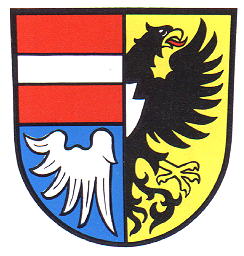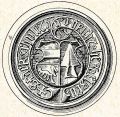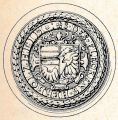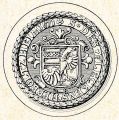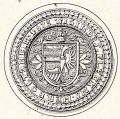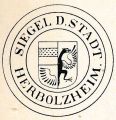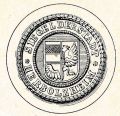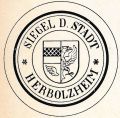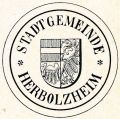Herbolzheim: Difference between revisions
Knorrepoes (talk | contribs) m (Text replacement - ". ===Origin/meaning===" to ". |- |'''English''' | {{blazon wanted}} |} ===Origin/meaning=== ") |
Knorrepoes (talk | contribs) m (Text replacement - "===Origin/meaning=== The" to "===Origin/meaning=== The") |
||
| Line 21: | Line 21: | ||
===Origin/meaning=== | ===Origin/meaning=== | ||
The village originally was a loan of the Lords of Üsenberg to the Bishops of Strassbourg (France) and became Austrian in 1415. The oldest seal of the town dates from 1520 and shows the wing of the arms of Üsenberg combined with the arms of Austria in the upper part and a plough-iron (probably an old village-symbol) in the lower part. | The village originally was a loan of the Lords of Üsenberg to the Bishops of Strassbourg (France) and became Austrian in 1415. The oldest seal of the town dates from 1520 and shows the wing of the arms of Üsenberg combined with the arms of Austria in the upper part and a plough-iron (probably an old village-symbol) in the lower part. | ||
Revision as of 08:34, 18 July 2022
This page is part of the German heraldry portal Deutsche Wappensammlung |
Heraldry of the World |
|
German heraldry:
|
Selected collector's items from Germany:
|
HERBOLZHEIM
State : Baden-Württemberg
District (Kreis) : Emmendingen
Additions : 1972 Wagenstadt; 1974 Bleichheim; 1975 Broggingen, Tutschfelden,
| German |
In halbgeteiltem und gespaltenem Schild vorne oben in Rot ein silberner Balken, unten in Blau ein silberner Flügel, hinten in Gold ein halber, golden bewehrter und rot bezungter schwarzer Adler am Spalt, die Brust belegt mit einer halben gestürzten silbernen Pflugschar. |
| English | No blazon/translation known. Please click here to send your (heraldic !) blazon or translation |
Origin/meaning
The village originally was a loan of the Lords of Üsenberg to the Bishops of Strassbourg (France) and became Austrian in 1415. The oldest seal of the town dates from 1520 and shows the wing of the arms of Üsenberg combined with the arms of Austria in the upper part and a plough-iron (probably an old village-symbol) in the lower part.
Later that century (around 1586) the arms were changed; the right part was now the combination of Üsenberg and Austria (see also Endingen and Kenzingen), whereas half a German Imperial eagle was place in the left part. On the eagle the plough-iron was placed. The arms never changed since.
The seals of the city:
| The arms by Hupp in the Kaffee Hag albums +/- 1925 |
Contact and Support
Partners:
Your logo here ?
Contact us
© since 1995, Heraldry of the World, Ralf Hartemink 
Index of the site
Literature : Stadler, 1964-1971, 8 volumes.


